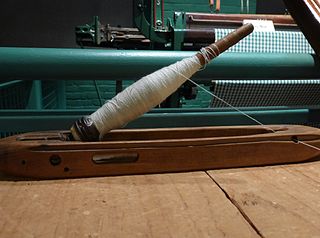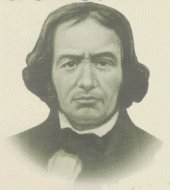
The rotary hook (aka rotating hook) is a Bobbin driver design used in lockstitch sewing machines of the 19th and 20th century and beyond. It triumphed over competing designs because it can run at higher speeds with less vibration.

The rotary hook (aka rotating hook) is a Bobbin driver design used in lockstitch sewing machines of the 19th and 20th century and beyond. It triumphed over competing designs because it can run at higher speeds with less vibration.

The rotary hook continuously rotates in place, hooking the upper thread each time its pointed tip passes the 12 o'clock position. Enough upper thread is pulled from above to pass around the bobbin case, which sits loosely inside the hook frame such that loops of thread can pass completely over it. The excess thread, no longer needed, is then pulled back upward by the sewing machine's take-up arm.
This arrangement is mechanically very simple but also introduces a significant limitation. Since the lower bobbin must pass completely through the upper thread, and the upper thread necessary to complete this passage must be completely withdrawn by the take-up arm, the lower bobbin must either be very small or the take-up arm must have a very long stroke.
The technology was invented by Allen B. Wilson in 1851, in steps. Wilson had just left an unsatisfactory business relationship in order to partner with Nathaniel Wheeler, who was impressed by a model of Wilson's vibrating shuttle machine. Ever since developing the vibrating shuttle, Wilson had been ruminating on a plan for a machine that used a rotating hook combined with a traditional reciprocating bobbin. For this hybrid machine he received patent US 8296,issued 1851-Aug-12, (reissued as RE914 on 28 February 1860). Knowing that such a machine would surely lead to patent litigation with his former partners who had bought out the patent for the vibrating shuttle, Wilson kept working, and developed a refined design which kept the bobbin stationary. He filed for patent, and the partners built their first production rotary hook machine the same year, selling it for US$35 (US$891 adjusted). The next year patent US 9041,issued 1852-June-15, was awarded. [1]
The rotary hook design was then called the "Wheeler & Wilson principle" after Wilson's partnership with Wheeler. [2]
Just two years later, in 1853, Scientific American took notice:
* Mr. Howe is mentioned due to the patent thicket that threatened to put the smaller sewing machine companies out of business.
Later, once the patents had expired, the White Sewing Machine Company used it in the popular 'White Family Rotary' machine.

Singer Corporation is an American manufacturer of consumer sewing machines, first established as I. M. Singer & Co. in 1851 by Isaac M. Singer with New York lawyer Edward C. Clark. Best known for its sewing machines, it was renamed Singer Manufacturing Company in 1865, then the Singer Company in 1963. It is based in La Vergne, Tennessee, near Nashville. Its first large factory for mass production was built in 1863 in Elizabeth, New Jersey.

A sewing machine is a machine used to sew fabric and materials together with thread. Sewing machines were invented during the first Industrial Revolution to decrease the amount of manual sewing work performed in clothing companies. Since the invention of the first sewing machine, generally considered to have been the work of Englishman Thomas Saint in 1790, the sewing machine has greatly improved the efficiency and productivity of the clothing industry.

A bobbin is a spindle or cylinder, with or without flanges, on which wire, yarn, thread or film is wound. Bobbins are typically found in sewing machines, cameras, and within electronic equipment. In non-electrical applications the bobbin is used for tidy storage without tangles.

A lockstitch is the most common mechanical stitch made by a sewing machine. The term "single needle stitching", often found on dress shirt labels, refers to lockstitch.

An overlock is a kind of stitch that sews over the edge of one or two pieces of cloth for edging, hemming, or seaming. Usually an overlock sewing machine will cut the edges of the cloth as they are fed through, though some are made without cutters. The inclusion of automated cutters allows overlock machines to create finished seams easily and quickly. An overlock sewing machine differs from a lockstitch sewing machine in that it uses loopers fed by multiple thread cones rather than a bobbin. Loopers serve to create thread loops that pass from the needle thread to the edges of the fabric so that the edges of the fabric are contained within the seam.

Barthélemy Thimonnier was a French inventor, who is attributed with the invention of the first sewing machine that replicated sewing by hand. He was born in L'Arbresle, in Rhône in France.

Cotton-spinning machinery refers to machines which process prepared cotton roving into workable yarn or thread. Such machinery can be dated back centuries. During the 18th and 19th centuries, as part of the Industrial Revolution cotton-spinning machinery was developed to bring mass production to the cotton industry. Cotton spinning machinery was installed in large factories, commonly known as cotton mills.

Elna is a Swiss brand and former manufacturer of textile machines, including fabric presses and sewing, overlock and coverstitch machines. Elna sewing machines are included in the collections of the Museum of Design, Zürich, Tekniska museet, the Philadelphia Museum of Art, and the Museum of Modern Art.
Textile manufacturing is one of the oldest human activities. The oldest known textiles date back to about 5000 B.C. In order to make textiles, the first requirement is a source of fibre from which a yarn can be made, primarily by spinning. The yarn is processed by knitting or weaving to create cloth. The machine used for weaving is the loom. Cloth is finished by what are described as wet process to become fabric. The fabric may be dyed, printed or decorated by embroidering with coloured yarns.

Ring spinning is a method of spinning fibres, such as cotton, flax or wool, to make a yarn. The ring frame developed from the throstle frame, which in its turn was a descendant of Arkwright's water frame. Ring spinning is a continuous process, unlike mule spinning which uses an intermittent action. In ring spinning, the roving is first attenuated by using drawing rollers, then spun and wound around a rotating spindle which in its turn is contained within an independently rotating ring flyer. Traditionally ring frames could only be used for the coarser counts, but they could be attended by semi-skilled labour.

Bradford Industrial Museum, established 1974 in Moorside Mills, Eccleshill, Bradford, United Kingdom, specializes in relics of local industry, especially printing and textile machinery, kept in working condition for regular demonstrations to the public. There is a Horse Emporium in the old canteen block plus a shop in the mill, and entry is free of charge.

Allen Benjamin Wilson (1823–1888) was an American inventor famous for designing, building and patenting some of the first successful sewing machines. He invented both the vibrating and the rotating shuttle designs which, in turns, dominated all home lockstitch sewing machines. With various partners in the 19th century he manufactured reliable sewing machines using the latter shuttle type.
Wheeler & Wilson was an American company which produced sewing machines. The company was started as a partnership between Allen B. Wilson and Nathaniel Wheeler after Wheeler agreed to help Wilson mass-produce a sewing machine he designed. The two launched their enterprise in the early 1850s, and quickly gained widespread acclamation for their machines' designs. Both Wheeler and Wilson died in the late 19th century, resulting in the company's sale to the Singer Corporation. Shortly after, the Singer Corporation phased out Wheeler & Wilson's designs. The company sold a total of nearly 2,000,000 sewing machines during its existence.

The United States provided many inventions in the time from the Colonial Period to the Gilded Age, which were achieved by inventors who were either native-born or naturalized citizens of the United States. Copyright protection secures a person's right to his or her first-to-invent claim of the original invention in question, highlighted in Article I, Section 8, Clause 8 of the United States Constitution, which gives the following enumerated power to the United States Congress:
To promote the Progress of Science and useful Arts, by securing for limited Times to Authors and Inventors the exclusive Right to their respective Writings and Discoveries.
The Singer Model 27 and later model 127 were a series of lockstitch sewing machines produced by the Singer Manufacturing Company from the 1880s to the 1960s.. They were Singer's first sewing machines to make use of "vibrating shuttle" technology. Millions were produced. They are all steel and cast iron, and were built before the advent of planned obsolescence, and so they were designed to be repaired rather than replaced. Consequently many remain today, some in collections and others still in service. In company literature they were called "the woman's faithful friend the world over".
A vibrating shuttle is a bobbin driver design used in home lockstitch sewing machines during the second half of the 19th century and the first half of the 20th century. It supplanted earlier transverse shuttle designs, but was itself supplanted by rotating shuttle designs.

Throughout history, lockstitch sewing machines have used a variety of methods to drive their bobbins so as to create the lockstitch.
The White Family Rotary or White FR was the first sewing machine produced by the White Sewing Machine Company using a rotary hook bobbin driver. It joined the successful White Vibrating Shuttle on White's expanding product line and eventually eclipsed it. It was originally sold as a treadle with cabinet or as a hand-crank with carrying case; later, add-on electric motors with foot or knee control were available pre-installed or as a field upgrade. Typical cost for this machine as a treadle with a cabinet was US$65 in 1909, which is about US$1532 adjusted.

The White Sewing Machine was the first sewing machine from the White Sewing Machine Company. It used a vibrating shuttle bobbin driver design; for that reason, and to differentiate it from the later White models that used a rotary hook design instead, it came to be known as the "White Vibrating Shuttle" or "White VS". In 1879 it cost USD50 to US$125 depending on which table or cabinet it was to be mounted in. The White VS continued in production, with improvements, until the early 1900s.

The Singer Featherweight is a model series of lockstitch domestic sewing machines produced by the Singer Manufacturing Company from 1933 to 1968, significant among sewing machines for their continuing popularity, active use by quilters and high collector's value.